Stone keep castles are quintessential medieval castles, the image that is conjured up in our minds when we think of the word ‘castle’. Primarily, these castles took the form of a free-standing stone tower or ‘keep’, which could vary greatly in size and appearance.
Stone keep castles would typically have additional fortifications such as earthworks, moats or wall circuits, but these features were extremely diverse in practice – although there are some regional variations, stone keep castles were never identical.
A Guide to Stone Keep Castles
Origins of Stone Keep Castles
Stone keep castles began to appear in the 10th century and became increasingly popular in northern Europe during the 11th and 12th centuries. Initially, the very earliest castles, built in the motte-and-bailey design, featured wooden keeps atop earthwork mounds.
By the 11th century the feudal system, based around land ownership and labour obligations, had spread across northern Europe, and castles too had spread as they were an excellent way for a lord to secure control over his land, and make a statement of political power.
Very slowly, wooden motte-and-bailey castles were increasingly abandoned in favour of stone keep castles, or else they were converted to stone, although it is important to note that this process was uneven and affected different regions at different times.
It seems likely that there were two primary reasons for the transition from wooden motte-and-bailey castles to stone keep castles. Wooden fortifications had certain military disadvantages as they were theoretically vulnerable to fire, potentially required regular rebuilding work due to decay, and were increasingly ineffective when faced with advancing siege technology.
However, it is important to note that some studies have suggested that wooden castles could be as strong and complex as stone fortifications.
Nevertheless, stone towers were incredibly strong military assets, not only because of their defensive capabilities but also because of their imposing psychological effect upon any enemy that sought to besiege them.
It is likely that symbolism was the other primary reason that stone became the most popular castle building material. Not only was stone perceived to be a more powerful material, but it was also far more expensive to use, and a stone keep castle required a great deal of time and money to construct.
Therefore, any lord who built one could expect to exponentially boost his prestige and political power, impressing not only the tenants who lived on his land but also his fellow lords and potential rivals.

Etymology
The term ‘keep’ was not used by contemporary writers in the medieval period to refer to free-standing stone castles. The English word ‘keep’ comes from the middle English word for a cask or barrel, which was kype – initially it was used to refer to the shell keep at Guînes in the late 14th century, likely because it resembled a barrel.
Slowly the term was applied to other shell keeps throughout the 15th century, and by the 16th century, it had spread to become the common way to refer to free-standing stone towers in castles.
In reality, medieval writers themselves used a variety of terms to refer to the free-standing stone towers that we now call keeps. Often they used Latin: turris (‘tower’), turris castri (‘castle tower’), or magna turris (‘great tower’).
The Latin dominarium, meaning ‘lordship’, formed the origin for the French term donjon, which came to be used by the French to refer to stone keep castles in the 12th century.
Thanks to the meaning of its Latin origin, donjon associated the building of the keep with the power of landowners. In a similar way, the term torre del homenaje (‘tower of homage’) used by medieval Spanish writers also symbolically linked the keep to the system of land ownership and obligations inherent in feudalism.
Donjon became dungeon in English – initially, the dungeon was used to mean keep, but later came to be associated with a kind of prison.
As a result of the variation in terms used to refer to free-standing stone castles, the word ‘keep’ is used very carefully by many historians, and some of them prefer to use donjon. For the sake of simplicity, I will continue to use ‘keep’ in this article.
Description of Stone Keep Castles
Initially, stone keeps were built with a rectangular or square shape – Norman castles always had four sides, with keeps in England tending to be square and those in Normandy and France being built in the barlongue style, with their length being twice their width.
However, during the 12th century, new shapes began to be used. These included circular keeps, such as those constructed by Philip II of France to control his new conquests, and quatrefoil keeps, a symmetrical shape formed with four overlapping circles of equal diameter (see Château d’Étampes in France).
In England too the shape of stone keeps changed, and more complex polygonal keeps began to emerge.
As a structure, the keep was incredibly powerful. Typically a keep was built with great walls, up to 7 metres thick in some cases – not only did these walls provide the castle with defences which were almost impregnable until the invention of the trebuchet in the late 12th century, but they also helped to keep the castle warm in winter and cool in the summer months.
Norman keeps in particular boasted buttresses, stone structures projecting from the walls in order to strengthen the keep. The stone keep could be up to 4 storeys high, allowing a large amount of room inside for storage or living space.
Entrances to stone keeps were often raised to the first storey to make access to the door harder for attackers – in this case, a wooden or stone staircase would have been constructed.

As time went on, these stone staircases became more elaborate, and many were even encased in additional walls to offer further protection (a good example of this is the staircase forebuilding at Castle Rising in England, which is highly decorated).
Inside, the keep was divided into rooms with much thinner internal walls – generally, only the first floor of the keep would be vaulted, with higher floors being constructed of wood. An excellent example of a Norman rectangular keep would be Goodrich castle, with its thick walls and buttressed exterior.

Construction of stone keep castles was immensely expensive, which perhaps helps to explain their slow spread across Medieval Europe. Unlike motte-and-bailey castles – which were built of freely available wood and earth, and constructed by unskilled, often unfree (and therefore unpaid) labour – stone keeps required skilled craftsmen and masons who would have to be paid a wage.
There were also enormous costs involved in quarrying and transporting the stone the castle was actually built of. Norwich Castle in England, which started to be built in 1067 following the Norman invasion, was constructed entirely of Normandy limestone brought from Caen, the transport of which was enormously costly and time-consuming.
Stone keeps were also very slow to build, partly due to the need to transport heavy building material to the site, but also due to the use of lime mortar in the period, which only allowed builders to add around 3.5 metres of height to a wall each year. It was typical for stone keep castles to take around 10 years to build.

Another kind of stone keep castle that developed in the 12th century was the shell keep castle or donjon annulaire as they were known in French. Generally, these shell keeps were the castles that made use of existing motte-and-bailey fortifications.
Many mottes were simply not strong enough to support the weight of a free-standing stone keep, so as a solution, castle builders constructed a thinner stone wall around the edge of the motte – as the wall was thinner it was much lighter.
Buildings were then constructed inside the circuit of the wall, often against the inside of the walls so as to strengthen them further. These buildings essentially replaced the rooms that would have been inside a solid, free-standing stone keep castle, and the space at the centre of the shell keep would have formed a courtyard.
Furthermore, a smaller wall known as a chemise was sometimes constructed around the base of the motte, adding to the castle’s defences. Restormel Castle in England was a motte-and-bailey converted into a shell keep in the 12th century.

Although the circular shape of shell keeps was more effective than square stone keeps against later siege technology, this is not why the design was adopted – rather circular shell keeps were built to exploit existing earthwork mottes, and to upgrade existing motte-and-bailey castles.
Function of Stone Keep Castles
Historians often debate the function of stone keep castles. Certainly, the stone keep was an exceptionally powerful defensive building – it was not until the development of the trebuchet in the later 12th century that these fortifications began to become more vulnerable to siege engines.
Until then, besiegers could not hope to damage the keep with missiles, and mining to destroy the walls was rarely attempted.
However, stone keep castles did contain some military flaws, although admittedly they were flaws that only became more apparent as time went on, for example, the square shape of the keep created ‘dead space’ which defenders could not shoot at with crossbows, and which could aid attackers.
Moreover, many stone keep castles are highly decorated, suggesting that the primary aim of their construction was not military, but rather political.
Norwich Castle features elaborate blind arcading and Romanesque arches, as well as a large ceremonial entrance that would be vulnerable to attack in the event of a siege.

Early castles like Colchester and the White Tower in London are highly decorated and were clearly intended to boost the prestige of their builders.
Advantages and Disadvantages of Stone Keep Castles
Stone keep castles held many advantages over the motte-and-bailey castles that they superseded. Primarily, they were undeniably stronger defensive fortifications – until the late 12th and early 13th century, stone keep castles were effectively impossible to breach.
In addition to this, the use of stone in these castles offered lords and kings a chance to boost their prestige enormously. Thanks to their very great cost and imposing appearance, stone keep castles expressed the power of a lord to his feudal subjects, as well as reminding other local rulers of his influence, wealth and importance.

However, there were also several problems with stone keep castles. The need for skilled labour and huge quantities of stone during their construction meant that they were very expensive.
In addition to this, they took an extremely long time to build, making them an ineffective defensive structure for a ruler who sought to quickly secure newly captured land from immediate counterattack.
Furthermore, the square shape of many stone keeps meant that they later became increasingly vulnerable to attack from advancing siege engine, such as trebuchets, in the late 12th century and beyond.
Spread and Decline of Stone Keep Castles
As mentioned previously, the spread of stone keep castles across Europe was slow and rather patchy.
Following a phase of building in Northern Europe in the 11th century in which most stone keeps were rectangular, these castles began to vary more in appearance into the 12th century – perhaps partly due to new military theory concerning the effectiveness of rounded walls, but most likely for political reasons.

Philip II of France, for example, built a series of 20 or more rounded keeps in the late 12th and early 13th century, in a clear attempt to stamp his new political authority on the landscape.
Square keeps remained popular in England, although some innovative polygonal stone keeps were constructed during the 12th century.
Iberia was split between Christian and Islamic kingdoms in the Medieval period, both of which had usually relied on watchtowers to defend territory – however, thanks to the influence of France, square stone keeps began to be constructed in the Christian kingdoms during the first half of the 12th century, and by the second half the practice had spread to the Muslims.
Developments in the rest of Europe differed. In the Low Countries, lords would build rectangular towers, but usually, they stood alone and were not incorporated into a larger castle fortification as they were in England and France.
In Germany stone keep castles replaced motte-and-bailey defences in the 12th century, but they did not fulfil the same residential function that other western European castles did and were primarily military.
Several developments reduced the popularity and effectiveness of stone keep castles, chief among which was the emergence of concentric castles, which did not require a central free-standing keep.
Instead, they featured multiple layers of concentric walls, punctuated by towers – as a result, many new castles, such as Framlingham in England, were built without keeps. In addition to this, gatehouses increased greatly in size, so that they rivalled stone keeps.
A strong gatehouse, built next to two large defensive towers, negated the need for a central stone tower in a castle.
